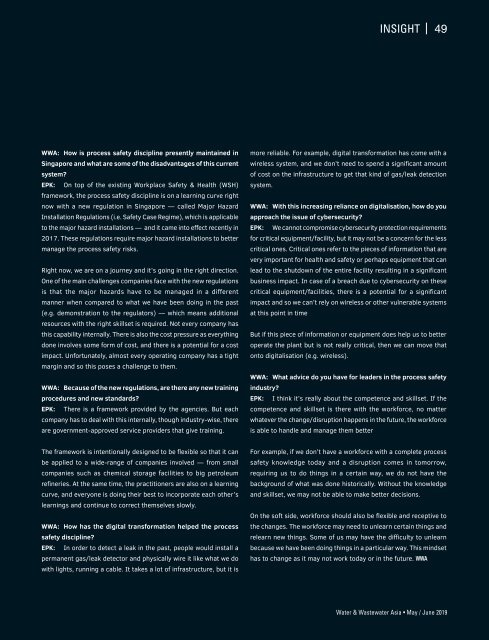Water & Wastewater Asia May/June 2019
Water & Wastewater Asia is an expert source of industry information, cementing its position as an indispensable tool for trade professionals in the water and wastewater industry. As the most reliable publication in the region, industry experts turn this premium journal for credible journalism and exclusive insight provided by fellow industry professionals. Water & Wastewater Asia incorporates the official newsletter of the Singapore Water Association (SWA).
Water & Wastewater Asia is an expert source of industry information, cementing its position as an indispensable tool for trade professionals in the water and wastewater industry. As the most reliable publication in the region, industry experts turn this premium journal for credible journalism and exclusive insight provided by fellow industry professionals. Water & Wastewater Asia incorporates the official newsletter of the Singapore Water Association (SWA).
You also want an ePaper? Increase the reach of your titles
YUMPU automatically turns print PDFs into web optimized ePapers that Google loves.
INSIGHT | 49<br />
WWA: How is process safety discipline presently maintained in<br />
Singapore and what are some of the disadvantages of this current<br />
system?<br />
EPK: On top of the existing Workplace Safety & Health (WSH)<br />
framework, the process safety discipline is on a learning curve right<br />
now with a new regulation in Singapore — called Major Hazard<br />
Installation Regulations (i.e. Safety Case Regime), which is applicable<br />
to the major hazard installations — and it came into effect recently in<br />
2017. These regulations require major hazard installations to better<br />
manage the process safety risks.<br />
Right now, we are on a journey and it’s going in the right direction.<br />
One of the main challenges companies face with the new regulations<br />
is that the major hazards have to be managed in a different<br />
manner when compared to what we have been doing in the past<br />
(e.g. demonstration to the regulators) — which means additional<br />
resources with the right skillset is required. Not every company has<br />
this capability internally. There is also the cost pressure as everything<br />
done involves some form of cost, and there is a potential for a cost<br />
impact. Unfortunately, almost every operating company has a tight<br />
margin and so this poses a challenge to them.<br />
WWA: Because of the new regulations, are there any new training<br />
procedures and new standards?<br />
EPK: There is a framework provided by the agencies. But each<br />
company has to deal with this internally, though industry-wise, there<br />
are government-approved service providers that give training.<br />
more reliable. For example, digital transformation has come with a<br />
wireless system, and we don’t need to spend a significant amount<br />
of cost on the infrastructure to get that kind of gas/leak detection<br />
system.<br />
WWA: With this increasing reliance on digitalisation, how do you<br />
approach the issue of cybersecurity?<br />
EPK: We cannot compromise cybersecurity protection requirements<br />
for critical equipment/facility, but it may not be a concern for the less<br />
critical ones. Critical ones refer to the pieces of information that are<br />
very important for health and safety or perhaps equipment that can<br />
lead to the shutdown of the entire facility resulting in a significant<br />
business impact. In case of a breach due to cybersecurity on these<br />
critical equipment/facilities, there is a potential for a significant<br />
impact and so we can’t rely on wireless or other vulnerable systems<br />
at this point in time<br />
But if this piece of information or equipment does help us to better<br />
operate the plant but is not really critical, then we can move that<br />
onto digitalisation (e.g. wireless).<br />
WWA: What advice do you have for leaders in the process safety<br />
industry?<br />
EPK: I think it’s really about the competence and skillset. If the<br />
competence and skillset is there with the workforce, no matter<br />
whatever the change/disruption happens in the future, the workforce<br />
is able to handle and manage them better<br />
The framework is intentionally designed to be flexible so that it can<br />
be applied to a wide-range of companies involved — from small<br />
companies such as chemical storage facilities to big petroleum<br />
refineries. At the same time, the practitioners are also on a learning<br />
curve, and everyone is doing their best to incorporate each other’s<br />
learnings and continue to correct themselves slowly.<br />
WWA: How has the digital transformation helped the process<br />
safety discipline?<br />
EPK: In order to detect a leak in the past, people would install a<br />
permanent gas/leak detector and physically wire it like what we do<br />
with lights, running a cable. It takes a lot of infrastructure, but it is<br />
For example, if we don’t have a workforce with a complete process<br />
safety knowledge today and a disruption comes in tomorrow,<br />
requiring us to do things in a certain way, we do not have the<br />
background of what was done historically. Without the knowledge<br />
and skillset, we may not be able to make better decisions.<br />
On the soft side, workforce should also be flexible and receptive to<br />
the changes. The workforce may need to unlearn certain things and<br />
relearn new things. Some of us may have the difficulty to unlearn<br />
because we have been doing things in a particular way. This mindset<br />
has to change as it may not work today or in the future. WWA<br />
<strong>Water</strong> & <strong>Wastewater</strong> <strong>Asia</strong> • <strong>May</strong> / <strong>June</strong> <strong>2019</strong>


















